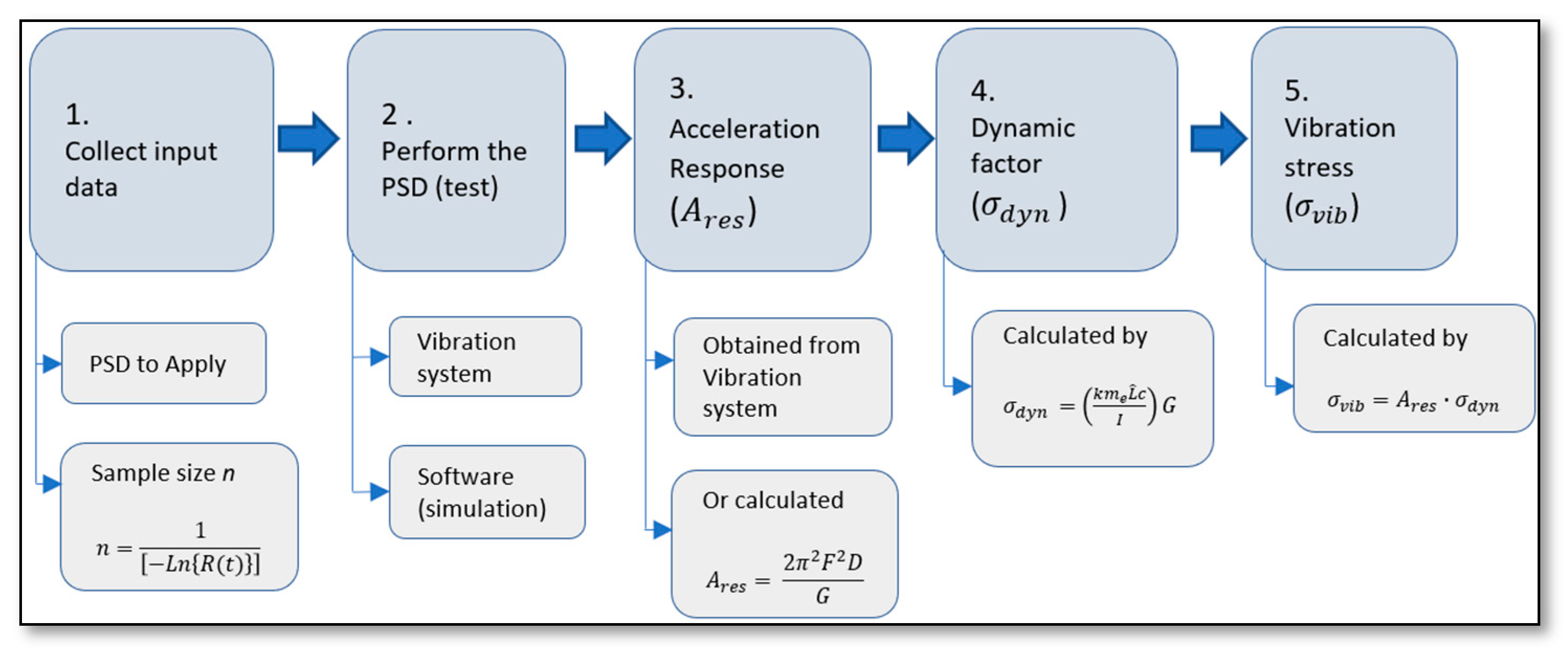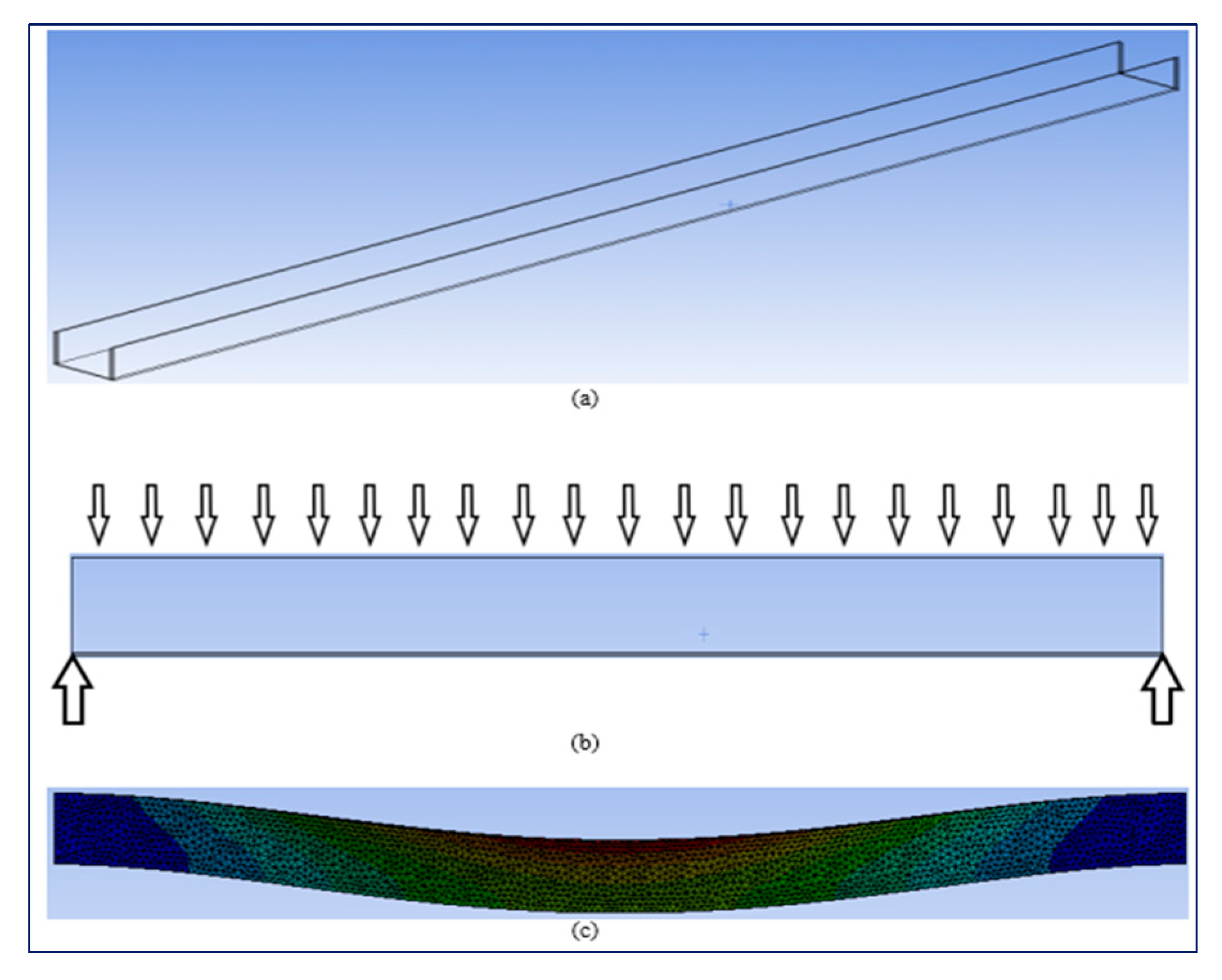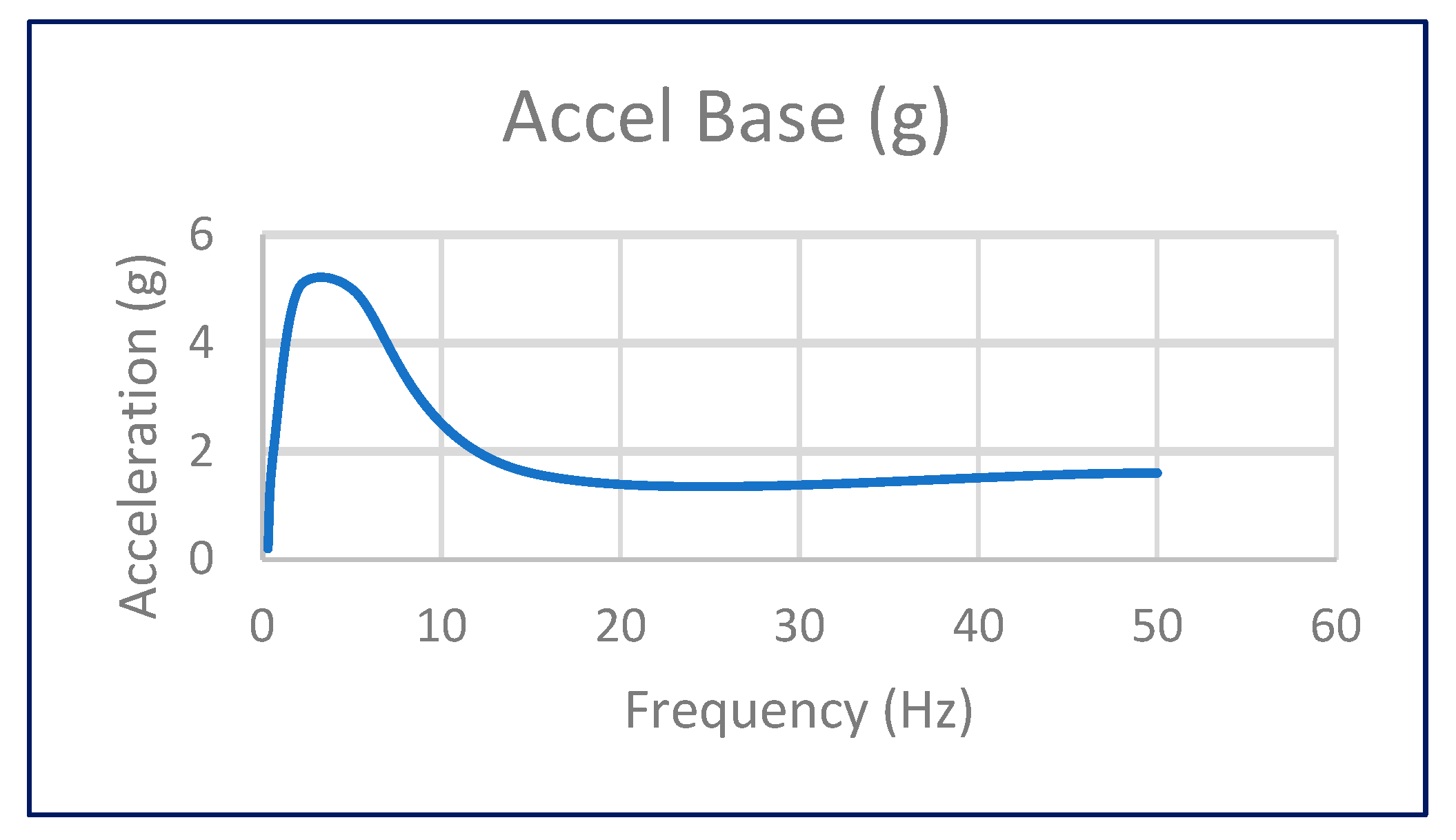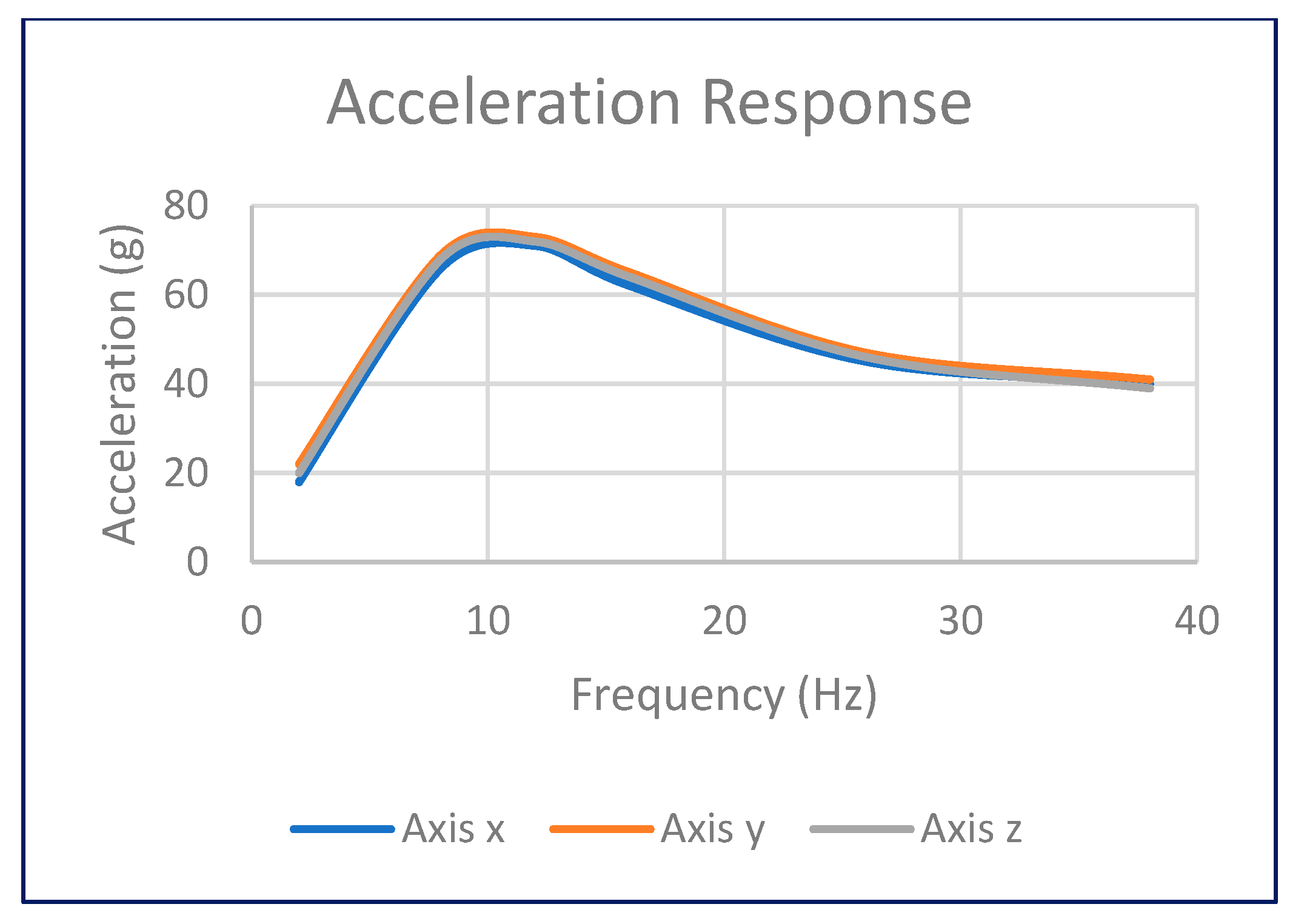Vibration Fatigue Life Reliability Cable Trough Assessment by Using Weibull Distribution
Abstract
1. Introduction
2. General Random Vibration Background
3. Proposed Random Vibration—Stress Method
3.1. Random Vibration Stress Analysis
3.2. Weibull Statistics Analysis
3.3. Weibull Stress Random Analysis
4. Numerical Application
4.1. Random Vibration Stress Analysis
4.2. Weibull Stress Parameters
4.3. Weibull Stress Random Analysis
4.4. Material’s Strength for Variant Stress Analysis
4.5. Cycle Random Analysis
5. Conclusions
- 1.
- The method proposed in this paper allowed us to estimate and predict the fatigue life of cable trough structures based on the stresses fatigue–vibration–Weibull analysis.
- 2.
- The proposed method lets us determine the Weibull parameters directly from the principal vibration stress values obtained after the product’s application, mass, and resonance frequencies were considered in the analysis.
- 3.
- 4.
- The efficiency of the proposed method depends on the accuracy on which the acceleration response and the dynamic factor are determined. This fact is because they determine the principal vibration stress values on which the Weibull parameters are determined.
- 5.
- We highlight that although it seems to be possible to include in the proposed method, the component’s material deformation, because it is based on material properties such as elasticity and ductility, then due to, those material properties affect in the vibration analysis, the acceleration response and dynamic factor, then to generalize the proposed method to the deformation more research must be undertaken.
Author Contributions
Funding
Institutional Review Board Statement
Informed Consent Statement
Data Availability Statement
Conflicts of Interest
References
- Mršnik, M.; Slavič, J.; Boltežar, M. Frequency-domain methods for a vibration-fatigue-life estimation—Application to real data. Int. J. Fatigue 2013, 47, 8–17. [Google Scholar] [CrossRef]
- Jang, J.; Park, J.-W. Simplified Vibration PSD Synthesis Method for MIL-STD-810. Appl. Sci. 2020, 10, 458. [Google Scholar] [CrossRef]
- Irvine, T. A Fatigue Damage Spectrum Method for Comparing Power Spectral Density Base Input Specifications. Vibrationdata. 2014. Available online: https://vibrationdata.wordpress.com/ (accessed on 8 March 2023).
- Kumar, S.M. Analyzing Random Vibration Fatigue. Available online: https://ansys.com/ (accessed on 6 March 2023).
- Kong, Y.; Abdullah, S.; Schramm, D.; Omar, M.; Haris, S. Vibration Fatigue Analysis of Carbon Steel Coil Spring under Various Road Excitations. Metals 2018, 8, 617. [Google Scholar] [CrossRef]
- Lalanne, C. Fatigue Damage, 3rd ed.; John Wiley & Sons, Inc.: Hoboken, NJ, USA, 2014; Volume 4. [Google Scholar]
- Gao, H.; Huang, H.-Z.; Zhu, S.-P.; Li, Y.-F.; Yuan, R. A Modified Nonlinear Damage Accumulation Model for Fatigue Life Prediction Considering Load Interaction Effects. Sci. World J. 2014, 2014, 164378. [Google Scholar] [CrossRef] [PubMed]
- Barraza-Contreras, J.M.; Piña-Monarrez, M.R.; Molina, A.; Torres-Villaseñor, R.C. Random Vibration Fatigue Analysis Using a Nonlinear Cumulative Damage Model. Appl. Sci. 2022, 12, 4310. [Google Scholar] [CrossRef]
- Castillo, E.; Fernández-Canteli, A. A Unified Statistical Methodology for Modeling Fatigue Damage; Springer: Berlin/Heidelberg, Germany, 2009. [Google Scholar]
- Weibull, W. A Statistical Theory of the Strength of Materials; Generalstabens Litografiska Anstalts Förlag: Stockholm, Sweden, 1939. [Google Scholar]
- Lee, Y.-L.; Pan, J.; Hathaway, R.B.; Barkey, M.E. Fatigue Testing and Analysis: Theory and Practice; Elsevier Butter-worth-Heinemann: Burlington, MA, USA, 2005. [Google Scholar]
- Santecchia, E.; Hamouda, A.M.S.; Musharavati, F.; Zalnezhad, E.; Cabibbo, M.; El Mehtedi, M.; Spigarelli, S. A Review on Fatigue Life Prediction Methods for Metals. Adv. Mater. Sci. Eng. 2016, 2016, 9573524. [Google Scholar] [CrossRef]
- Gutierrez-Wing, E.S.; Bedolla-Hernández, J.; Vélez-Castán, G.; Cortés-García, C.; Szwedowicz-Wasik, D. Identification of Close Vibration Modes of a Quasi-Axisymmetric Structure: Complementary Study. Ing. Investig. Y Tecnol. 2013, 14, 207–222. [Google Scholar]
- White, P.G. Introducción al Análisis de Vibraciones; AzimaDLI: Woburn, MA, USA, 2010. Available online: https//AzimaDLI.com/ (accessed on 26 February 2023).
- Quigley, J.P.; Lee, Y.-L.; Wang, L. Review and Assessment of Frequency-Based Fatigue Damage Models. SAE Int. J. Mater. Manuf. 2016, 9, 565–577. [Google Scholar] [CrossRef]
- Harris, C.M.; Piersol, A.G. Shock and Vibration Handbook, 5th ed.; McGraw Hill: New York, NY, USA, 2002; Volume 15. [Google Scholar]
- Lindquist, E.S. Strength of materials and the Weibull distribution. Probabilistic Eng. Mech. 1994, 9, 191–194. [Google Scholar] [CrossRef]
- Monarrez, M.R.P.; Ramos-Lopez, M.L.; Alvarado-Iniesta, A.; Molina-Arredondo, R.D. Robust sample siza for Weibull demostartion test plan. Dyna 2016, 83, 52–57. [Google Scholar] [CrossRef]
- Jian, J.; Luo, H.; Li, T.; Zhang, G.; Cui, X. Fatigue life assessment of electromagnetic riveted carbon fiber reinforce plastic/aluminum alloy lap joints using Weibull distribution. In Proceedings of the 24th International Conference Engineering Mechanics, Svratka, Czech Republic, 14–17 May 2018; pp. 41–44. [Google Scholar] [CrossRef]
- Piña-Monarrez, M.R. Weibull stress distribution for static mechanical stress and its stress/strength analysis. Qual. Reliab. Eng. Int. 2017, 34, 229–244. [Google Scholar] [CrossRef]
- Berghmans, F.; Eve, S.; Held, M. An Introduction to Reliability of Optical Components and Fiber Optic Sensors. In NATO Science for Peace and Security Series B: Physics and Biophysics; Springer: Dordrecht, The Netherlands, 2007; pp. 73–100. [Google Scholar] [CrossRef]
- Frascio, M.; Avalle, M.; Monti, M. Fatigue strength of plastics components made in additive manufacturing: First experimental results. Procedia Struct. Integr. 2018, 12, 32–43. [Google Scholar] [CrossRef]
- Boehm, F.; Lewis, E. A stress-strength interference approach to reliability analysis of ceramics: Part I—fast fracture. Probabilistic Eng. Mech. 1992, 7, 1–8. [Google Scholar] [CrossRef]
- Filho, R.L.M.S.; Droguett, E.L.; Lins, I.D.; Moura, M.C.; Amiri, M.; Azevedo, R.V. Stress-Strength Reliability Analysis with Extreme Values based on q-Exponential Distribution. Qual. Reliab. Eng. Int. 2016, 33, 457–477. [Google Scholar] [CrossRef]
- Tijerina, M.B.; Monarrez, M.R.P.; Contrera, J.B. Weibull strength distribution and reliability S-N percentiles for tensile tests. Rev. De Cienc. Tecnológicas 2022, 5, 284–299. [Google Scholar] [CrossRef]
- Budynas, R.; Nisbett, J. Shigley’s Mechanical Engineering Design, 10th ed.; McGraw Hill: New York, NY, USA, 2015. [Google Scholar]
- Barraza-Contreras, J.M.; Piña-Monarrez, M.R.; Molina, A. Fatigue-Life Prediction of Mechanical Element by Using the Weibull Distribution. Appl. Sci. 2020, 10, 6384. [Google Scholar] [CrossRef]





| Frequency (Hz) | Acceleration (g) | Grms |
|---|---|---|
| 0.3 | 0.2 | 7.15 |
| 0.6 | 2.0 | |
| 2.0 | 5.0 | |
| 5.0 | 5.0 | |
| 15.0 | 1.6 | |
| 50.0 | 1.6 |
| Frequency (Hz) | Axis x | Axis y | Axis z |
|---|---|---|---|
| 2.0 | 18.0 | 22.0 | 20.0 |
| 8.0 | 66.0 | 69.0 | 68.0 |
| 12.0 | 71.0 | 73.0 | 72.0 |
| 16.0 | 62.0 | 65.0 | 64.0 |
| 26.0 | 45.0 | 47.0 | 46.0 |
| 38.0 | 40.0 | 41.0 | 39.0 |
| Frequency (Hz) | Equation (5) | Vibration Stress Equation (8) | |
|---|---|---|---|
| 2.0 | 60.0 | 5.50 | 330.00 |
| 8.0 | 203.0 | 1116.50 | |
| 12.0 | 216.0 | 1188.00 | |
| 16.0 | 191.0 | 1050.50 | |
| 26.0 | 138.0 | 759.00 | |
| 38.0 | 120.0 | 660.00 |
| n Equation (3) | Yi Equation (22) | µy Equation (17) | t0i Equation (18) | R(t0i) Equation (23) | σ2i Equation (19) | σ1i Equation (20) |
|---|---|---|---|---|---|---|
| 1 | −3.355 | −0.168 | 0.140 | 0.966 | 87.902 | 4459.989 |
| −3.312 | −1.938 | 0.144 | 0.964 | 90.124 | 4350.000 | |
| −2.970 | −0.149 | 0.176 | 0.950 | 110.090 | 3561.071 | |
| 2 | −2.442 | −0.122 | 0.240 | 0.917 | 149.993 | 2613.729 |
| 3 | −1.952 | −0.098 | 0.319 | 0.868 | 199.757 | 1962.581 |
| 4 | −1.609 | −0.080 | 0.390 | 0.819 | 244.211 | 1605.334 |
| 5 | −1.340 | −0.067 | 0.457 | 0.770 | 285.834 | 1371.566 |
| −1.094 | −0.640 | 0.527 | 0.716 | 330.000 | 1188.000 | |
| 6 | −1.116 | −0.056 | 0.521 | 0.721 | 325.909 | 1202.913 |
| 7 | −0.921 | −0.046 | 0.583 | 0.672 | 365.252 | 1073.342 |
| 8 | −0.747 | −0.037 | 0.646 | 0.623 | 404.468 | 969.274 |
| 9 | −0.587 | −0.029 | 0.709 | 0.574 | 444.068 | 882.837 |
| 10 | −0.438 | −0.022 | 0.774 | 0.525 | 484.538 | 809.101 |
| 11 | −0.297 | −0.015 | 0.841 | 0.475 | 526.385 | 744.778 |
| 12 | −0.160 | −0.008 | 0.911 | 0.426 | 570.190 | 687.561 |
| 13 | −0.026 | −0.001 | 0.985 | 0.377 | 616.668 | 635.739 |
| 0.000 | 0.000 | 1.000 | 0.368 | 626.131 | 626.131 | |
| 14 | 0.107 | 0.005 | 1.065 | 0.328 | 666.766 | 587.973 |
| 15 | 0.243 | 0.012 | 1.153 | 0.279 | 721.817 | 543.130 |
| 16 | 0.384 | 0.019 | 1.252 | 0.230 | 783.852 | 500.145 |
| 17 | 0.535 | 0.027 | 1.368 | 0.181 | 856.261 | 457.851 |
| 18 | 0.704 | 0.035 | 1.510 | 0.132 | 945.484 | 414.645 |
| 19 | 0.910 | 0.046 | 1.704 | 0.083 | 1066.630 | 367.550 |
| 1.094 | 0.640 | 1.897 | 0.050 | 1188.000 | 330.000 | |
| 20 | 1.216 | 0.061 | 2.037 | 0.034 | 1275.318 | 307.406 |
| n Equation (3) | Yi Equation (22) | µy Equation (17) | t0i Equation (18) | R(t0i) Equation (23) | Equation (19) | Equation (20) | Equation (28) | Cycle (Ni) Equation (34) |
|---|---|---|---|---|---|---|---|---|
| 1 | −3.355 | −0.168 | 0.140 | 0.966 | 87.902 | 4459.989 | 2186.044 | 1.081 × 1016 |
| −3.312 | −1.938 | 0.144 | 0.964 | 90.124 | 4350.000 | 2129.938 | 1.108 × 1016 | |
| −2.970 | −0.149 | 0.176 | 0.950 | 110.090 | 3561.071 | 1725.490 | 1.354 × 1016 | |
| 2 | −2.442 | −0.122 | 0.240 | 0.917 | 149.993 | 2613.729 | 1231.868 | 1.845 × 1016 |
| 3 | −1.952 | −0.098 | 0.319 | 0.868 | 199.757 | 1962.581 | 881.412 | 2.457 × 1016 |
| 4 | −1.609 | −0.080 | 0.390 | 0.819 | 244.211 | 1605.334 | 680.562 | 3.003 × 1016 |
| 5 | −1.340 | −0.067 | 0.457 | 0.770 | 285.834 | 1371.566 | 542.866 | 3.515 × 1016 |
| −1.094 | −0.640 | 0.527 | 0.716 | 330.000 | 1188.000 | 429.000 | 4.058 × 1016 | |
| 6 | −1.116 | −0.056 | 0.521 | 0.721 | 325.909 | 1202.913 | 438.502 | 4.008 × 1016 |
| 7 | −0.921 | −0.046 | 0.583 | 0.672 | 365.252 | 1073.342 | 354.045 | 4.492 × 1016 |
| 8 | −0.747 | −0.037 | 0.646 | 0.623 | 404.468 | 969.274 | 282.403 | 4.974 × 1016 |
| 9 | −0.587 | −0.029 | 0.709 | 0.574 | 444.068 | 882.837 | 219.384 | 5.461 × 1016 |
| 10 | −0.438 | −0.022 | 0.774 | 0.525 | 484.538 | 809.101 | 162.281 | 5.959 × 1016 |
| 11 | −0.297 | −0.015 | 0.841 | 0.475 | 526.385 | 744.778 | 109.197 | 6.474 × 1016 |
| 12 | −0.160 | −0.008 | 0.911 | 0.426 | 570.190 | 687.561 | 58.686 | 7.012 × 1016 |
| 13 | −0.026 | −0.001 | 0.985 | 0.377 | 616.668 | 635.739 | 9.535 | 7.584 × 1016 |
| 0.000 | 0.000 | 1.000 | 0.368 | 626.131 | 626.131 | 0.000 | 7.700 × 1016 | |
| 14 | 0.107 | 0.005 | 1.065 | 0.328 | 666.766 | 587.973 | 39.397 | 8.200 × 1016 |
| 15 | 0.243 | 0.012 | 1.153 | 0.279 | 721.817 | 543.130 | 89.344 | 8.877 × 1016 |
| 16 | 0.384 | 0.019 | 1.252 | 0.230 | 783.852 | 500.145 | 141.853 | 9.640 × 1016 |
| 17 | 0.535 | 0.027 | 1.368 | 0.181 | 856.261 | 457.851 | 199.205 | 1.053 × 1017 |
| 18 | 0.704 | 0.035 | 1.510 | 0.132 | 945.484 | 414.645 | 265.419 | 1.163 × 1017 |
| 19 | 0.910 | 0.046 | 1.704 | 0.083 | 1066.630 | 367.550 | 349.540 | 1.312 × 1017 |
| 1.094 | 0.640 | 1.897 | 0.050 | 1188.000 | 330.000 | 429.000 | 1.461 × 1017 | |
| 20 | 1.216 | 0.061 | 2.037 | 0.034 | 1275.318 | 307.406 | 483.956 | 1.568 × 1017 |
| Vibration Analysis | Experimental Data | Formulation | Estimated Value |
|---|---|---|---|
| Profile Applied (PSD) | (See Table 1 and Figure 2) | - | - |
| Accel Resp (See Table 2 and Figure 5) | = 71.0 g = 73.0 g = 72.0 g | Equation (4) | * = 70.98 g * = 73.05 g * = 72.02 g |
| Dynamic Factor | - | Equation (5) | 5.5 |
| Vibration Stress (See Table 3) | = 1188 Psi = 330 Psi = 759 Psi | Equation (20) Equation (19) Equation (25) | = 1188 Psi = 330 Psi = 759 Psi |
| Weibull Parameter | - | Equation (12) | 1.7087 |
| Weibull Parameter | - | Equation (13) | 626.13 |
| Cycles to Failure (N) | - | Equation (34) | 1.108 × 1016 |
| Reliability R(t) | 0.964 | Equation (23) | 0.964 |
Disclaimer/Publisher’s Note: The statements, opinions and data contained in all publications are solely those of the individual author(s) and contributor(s) and not of MDPI and/or the editor(s). MDPI and/or the editor(s) disclaim responsibility for any injury to people or property resulting from any ideas, methods, instructions or products referred to in the content. |
© 2023 by the authors. Licensee MDPI, Basel, Switzerland. This article is an open access article distributed under the terms and conditions of the Creative Commons Attribution (CC BY) license (https://creativecommons.org/licenses/by/4.0/).
Share and Cite
Barraza-Contreras, J.M.; Piña-Monarrez, M.R.; Torres-Villaseñor, R.C. Vibration Fatigue Life Reliability Cable Trough Assessment by Using Weibull Distribution. Appl. Sci. 2023, 13, 4403. https://doi.org/10.3390/app13074403
Barraza-Contreras JM, Piña-Monarrez MR, Torres-Villaseñor RC. Vibration Fatigue Life Reliability Cable Trough Assessment by Using Weibull Distribution. Applied Sciences. 2023; 13(7):4403. https://doi.org/10.3390/app13074403
Chicago/Turabian StyleBarraza-Contreras, Jesús M., Manuel R. Piña-Monarrez, and Roberto C. Torres-Villaseñor. 2023. "Vibration Fatigue Life Reliability Cable Trough Assessment by Using Weibull Distribution" Applied Sciences 13, no. 7: 4403. https://doi.org/10.3390/app13074403
APA StyleBarraza-Contreras, J. M., Piña-Monarrez, M. R., & Torres-Villaseñor, R. C. (2023). Vibration Fatigue Life Reliability Cable Trough Assessment by Using Weibull Distribution. Applied Sciences, 13(7), 4403. https://doi.org/10.3390/app13074403








